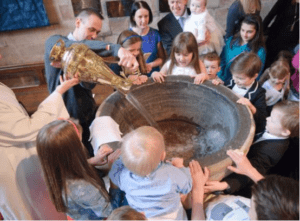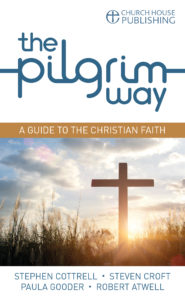Over thirty years ago, I became Vicar of Ovenden in Halifax. For all of that thirty years, I have been exploring the ancient-future discipline of helping to form adult Christians in the faith. The Christian tradition has a name for this discipline: catechesis.
It has long been my conviction that the renewal and reform most needed in the life of the Church of England and the Church in the United Kingdom is the renewal of catechesis: laying the good foundations of faith in the lives of enquirers and new Christians.
Today sees the publication of a new catechism, The Pilgrim Way, as part of the Pilgrim course. This short article gives the deeper biblical and historical background to catechesis and to the new catechism.
The New Testament
 The term catechesis is used from the New Testament onwards as a term for Christian formation and preparation for baptism and lifelong discipleship. The term is used for the period of formation beginning from first enquiry through to and beyond baptism and being established in the faith.
The term catechesis is used from the New Testament onwards as a term for Christian formation and preparation for baptism and lifelong discipleship. The term is used for the period of formation beginning from first enquiry through to and beyond baptism and being established in the faith.
The gospels were written as tools for catechesis. Luke is explicitly written to Theophilus “so that you may know the truth concerning the things about which you have been catechized”.
John’s gospel begins with the journey of enquirers to Jesus and ends with an appeal to faith. The very heart of catechesis is introducing people to Jesus.
Catechesis is concerned with the whole of Christian formation not simply the learning of facts or doctrine.
One way of reading the story of the Emmaus road is as a paradigm story of catechesis: Jesus walks with those who are going in the wrong direction away from Jerusalem. The four means Jesus deploys in Christian formation are the building of community through listening; attending to the scriptures; prayer and the sacraments; and engaging in witness and mission. These are four means the Church has used in every age to grow disciples. Together they form the ways in which we discern the risen Christ.
There are four great metaphors for this process in Scripture. The first is the journey seen in Exodus and Exile; in the story of the two sons; in the Emmaus and Damascus Road and the earliest description of the Christian faith as the Way.
The other three metaphors are all found in 1 Corinthians 3: Christian formation is a labour of love, like parenting, giving a special diet to those not yet mature; it is a work of partnership with God and with others, like farming, sowing, watering and waiting; it is a work of development, like building, first laying a foundation and then teaching the new disciples how to build well in their own lives.
The word catechesis has at its centre the term “echo”. Good Christian formation is founded on repetition of certain texts and phrases which become embedded in the heart and a means of transformation (Carol Harrison, Listening in the Early Church, Oxford, 2013). The aim of Christian formation is to create a resounding inner echo of God’s living Word, an image of Christ at the centre of each disciple’s life through learning very simple core texts by heart.
The Early Church
Catechesis in the early centuries of the church was the work of several years of formation and instruction. To be baptised into a Christian minority was a serious decision.
Catechesis was important and continuous. It shaped much of the ordinary life of the Church, including its worship. The early Church deployed an annual cycle of formation leading up to baptism at Easter. Those who were catechumens and receiving instruction would enrol for baptism in January or February often in response to preaching on particular Sundays.
They would then receive further instruction during the forty days before Easter: the origin of Lent. The rest of the Church would keep Lent with them as a reminder of their own baptism (see William Harmless, Augustine and the Catechemenate, Pueblo, 1995)
Formation would include community, listening to the scriptures, prayer leading to the sacrament of baptism and the eucharist at Easter and sharing in God’s mission.
The core texts for instruction were the Apostles Creed and the Lord’s Prayer although a wide variety of scriptures were used. There is some evidence that the commandments and the beatitudes were also used in this way.
This pattern of formation was normally led by the bishop and was given priority in his ministry. He was assisted in this by the presbyters and deacons.
The pattern of formation was remarkably effective and led to the sustained growth of the Church, by the grace of God, as a minority community across the Roman empire.
Augustine has left us a small but powerful essay on catechesis: On instructing beginners in the faith. Augustine stresses above all the importance of joy in Christian formation:
“Our greatest concern is much more about how to make it possible for those who offer instruction in the faith to do so with joy. For the more they succeed in this, the more appealing they will be”
The Monastic Movements and the Mediaeval Church
From the conversion of Constantine onwards, the Church grew rapidly and became the majority religion of the Empire. Baptism as an infant became the norm, decreasing the focus on adult catechesis as the means of entering the Church.
Much of the wisdom on Christian formation was nurtured and developed by the monastic movements. The monastery was the place to be supported in living a countercultural Christian life in a rhythm of prayer, rest and work. Benedict seeks to establish in his rule “a school for the Lord’s service in which there is nothing sharp and nothing heavy” – an excellent guide in Christian formation.

The deep Christian formation found in the monastery then inspires the work of preaching, teaching and catechesis in parish churches. Europe was evangelised by religious communities establishing deep places of formation and prayer from which women and men were sent to love and teach the faith.
This pattern is evident in the evangelisation of Britain from Ireland from the north and by Augustine of Canterbury from the south. It is evident in the sending of missionaries from Britain into Scandinavia and Germany and in the revival of the great monasteries of France which led eventually to the founding of the great universities.
England from 1287-1530
In 1281 the Archbishop of Canterbury and the English bishops agreed a Lambeth declaration. The clergy were to expound the Christian faith no less than four times each year. The content of the faith they were to expound was as follows:
- The Apostles’ Creed
- The Lord’s Prayer
- The Commandments
- The 7 works of mercy (based on Matthew 25)
- The 7 vices
- The 7 virtues
- The 7 sacraments
These elements formed the basis for the teaching of Christian faith in a largely non-literate and non-book culture before the Reformation (see Eamonn Duffy, The Stripping of the Altars, Yale, 1992, Chapter 1, How Piers the Plowman learned his Paternoster).
 England from 1530-1740
England from 1530-1740
The English Reformers faced a new challenge: the teaching of the recast and reshaped Anglican faith and identity to a population learning to read in the midst of a technological and political revolution.
The key was the development of a simple catechism issued with the Book of Common Prayer in 1548 and revised in 1604 and again in 1662.
The catechism is based on Martin Luther’s shorter catechism. It is in a simple question and answer format making it easy to learn and remember. It is based around:
- The Apostles’ Creed
- The Lord’s Prayer
- The Ten Commandments
The familiar sentences about the sacraments were added at the 1604 revision.
The catechism was printed as a primer to help people learn to read. People would learn their letters first and then the be introduced to their first text: the catechism. This primer became the bestselling book of the 16th Century in Britain (by far).
The same texts were used in Morning and Evening Prayer and the service of Holy Communion. They were often written on large boards at the front of Churches.
All clergy were expected to give instruction in the catechism every Sunday by law. The pattern after ordination was first to pay attention to writing and giving your catechetical sermons which were continually revised and renewed.
This investment in catechesis was pursued with great energy. Between 1530 and 1740 there is evidence of over 1,000 different printed catechisms in English. All or part of over 600 still survive (see Ian Green, The Christians ABC, Catechisms and Catechizing in England, 1530-1740).
This focus on catechetical work also results in the Westminster Shorter Catechism of 1646 and the powerful series of addresses on catechesis by Richard Baxter, Vicar of Kidderminster, The Reformed Pastor, published in 1657 and hugely influential.
Catechisms become in this period a way of more closely defining doctrine as this became contested rather than simply means of teaching and communicating faith. For this reason they became longer and, paradoxically, less useful for teaching enquirers.
From 1740 to the present day
John and Charles Wesley and the Methodist movement make a very substantial contribution to the English tradition of catechesis through the creation of special provision for adults who are seeking to learn the faith through bands and classes. They return to the principles of the early Church in setting catechesis at the heart of the life of the local church with remarkable effect.
There is some evidence that these were imitated in home meetings in Anglican churches through the eighteenth and nineteenth centuries, which also saw the rise of the Sunday School movement and an immense investment in the teaching of the faith to children and young people.
Through the twentieth century, the disciplined practice of catechesis was in decline and neglected for much of the century. There are many reasons for the decline of the Church of England in the twentieth century but one of the most significant is the neglect of the regular, systematic teaching of the Christian faith to enquirers and new Christians.
The Roman Catholic Church invested significantly in catechesis in the period following the Second Vatican Council, publishing the Rite for the Christian Initiation of Adults in 1974 and the Catechism in 1994.
In the late 1980’s and through the 1990’s the discipline saw something of a revival of catechesis in the Church of England through the development of nurture groups and process evangelism courses (Alpha, Emmaus and Christianity Explored). This revival of catechesis remains the principal factor behind the growth in some parts of the Church of England over the last 30 years.
This rediscovery of catechesis was practice led: parishes discovered through trial and error what was effective in nurturing new Christians and then spread that good practice. This was supported by research (particularly by John Finney and Robert Warren). Theological connections began to be made with the catechetical practice of the early Church and with the Roman Catholic renewal of catechesis.
The Church of England sought to draw its parishes back to the principles of catechesis in the 1995 report, On the Way and to draw together liturgical practice and Christian formation. On The Way argues for a return to the four texts of the creed, the Lord’s Prayer, the Commandments and the Beatitudes. The report was not widely taken up but remains a key text for the study of the discipline. On the Way had significant influence on the development of the Common Worship initiation services.
In 2012, the House of Bishops of the Church of England commissioned further work on catechesis in what became the Pilgrim course. The four Pilgrim authors (Robert Atwell, Stephen Cottrell, Paula Gooder and myself) sought to work within this long tradition of catechesis in developing the Pilgrim materials in focussing on the four texts and also returning to the Emmaus road disciplines of listening to create community, attending to scripture, prayer and the sacraments and engaging in mission. Many other bishops and teachers contributed to the development of Pilgrim.
Pilgrim has been widely used across the Church since publication. Over 150,000 books and other resources have been sold.
 The Pilgrim Way – a new catechism
The Pilgrim Way – a new catechism
The Pilgrim authors printed the (largely forgotten) Revised Catechism of the Church of England as part of the Pilgrim Leader’s Guide, partly to show we were working in this ancient and modern tradition of catechesis (http://www.pilgrimcourse.org).
A couple of years ago we began work on a new catechism for Pilgrim, to support new Christians in their journey of faith. The Pilgrim Way was published as part of the faith section of the new Church of England website a couple of weeks ago. It is published this week as a short booklet, The Pilgrim Way, a guide to the Christian faith. We have consciously worked in the great tradition of Christian formation to develop a simple, accessible tool for a deeply spiritual and vital task of ministry.
A further renewal and revival of catechesis is needed in the contemporary Church of England, working within this great tradition but taking advantage of new digital technology to proclaim the gospel afresh in this generation.
+Steven Oxford
Order The Pilgrim Way from Church House Publishing


